
hotline:
17715390137
Tel/Wechat:
18101240246 (Technology)
0512-68565571
Email:mxenes@163.com (Sales Engineer)bkxc.bonnie@gmail.com
Scan the code to follow or search the official account on WeChat:
2D Materials Fronrier After paying attention,
click on the lower right corner to contact us,
Enter enterprise WeChat.
Professional Services Online

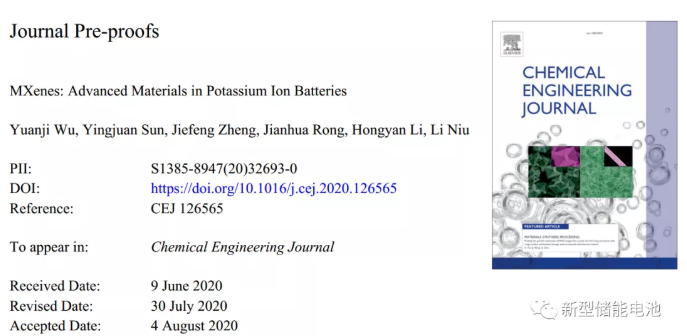
Author: Wu source base Corresponding author: Professor Niu Li Professor Li Hongyan
First unit: School of Chemistry and Materials, Jinan University
Literature research background and introduction
Lithium-ion batteries (LIBs), as rechargeable secondary batteries, are widely used in various portable electronic equipment, electric vehicles and other fields due to their high working voltage, high energy density, long cycle life, and environmental protection. However, the scarcity and uneven distribution of lithium resources have caused the price of lithium batteries to rise, limiting the further application of lithium. In order to meet the needs of society, there is an urgent need to develop low-cost and high-performance next-generation secondary batteries. Because the physical and chemical properties of sodium and potassium are similar to those of lithium, and the content of both in the earth‘s crust is high, sodium ion batteries (SIBs) and potassium ion batteries (PIBs) have become research hotspots. In particular, compared with Na, the standard electrode potential of K/K+ (-2.93 V, vs. SHE) is closer to Li/Li+ (-3.04 V, vs. SHE), while Na / Na+ (-2.71V, vs. SHE) . SHE) standard electrode potential is relatively low, so PIBs can have a higher working voltage and energy density. However, one of the biggest shortcomings of PIBs is the large ion radius of K. When potassium ions are repeatedly inserted/extracted from the electrode, it will cause huge volume changes, leading to irreversible damage to the electrode structure. Finding a suitable electrode material is the solution. The key to the problem.
MXenes is a new type of two-dimensional material derived from MAX phase. Due to its unique structure and electronic properties, it has broad application prospects in metal ion batteries. It is worth noting that the diffusion barrier of potassium ions on MXenes is very low, indicating that MXenes may have excellent rate performance when used as a negative electrode in potassium ion batteries. However, due to the theoretically low potassium storage capacity and faster capacity decay during charge and discharge, MXenes is not suitable for direct use as a negative electrode. Here, the author briefly introduced the potassium storage mechanism of MXenes and summarized the application of various modified MXenes in the field of potassium ion batteries, emphasizing the relationship between the structure of the material and the electrochemical performance. Through the analysis of various modification methods, I hope to see the future development direction of MXene in potassium-ion batteries and give readers inspiration.
Recently, Professor Li Hongyan from the School of Chemistry and Materials of Jinan University and Professor Niu Li from the School of Chemistry and Chemical Engineering of Guangzhou University published a review paper entitled "MXenes: Advanced Materials in Potassium Ion Batteries" in the Chemical Engineering Journal (IF=10.6). This article mainly introduces the application of MXenes in potassium electricity, and summarizes the potassium storage mechanism of MXenes. Specifically, the author classifies MXene-based materials according to structural characteristics, and introduces the applications of MXene, MXene-based composite materials and MXene derivative materials with special morphology in potassium electricity, emphasizing the structure and electricity The relationship between chemical properties. Finally, the author summarized the latest research progress of MXene in the field of potassium electricity, pointed out the main challenges facing this research, and proposed the most potential method to improve the electrochemical performance of MXene.
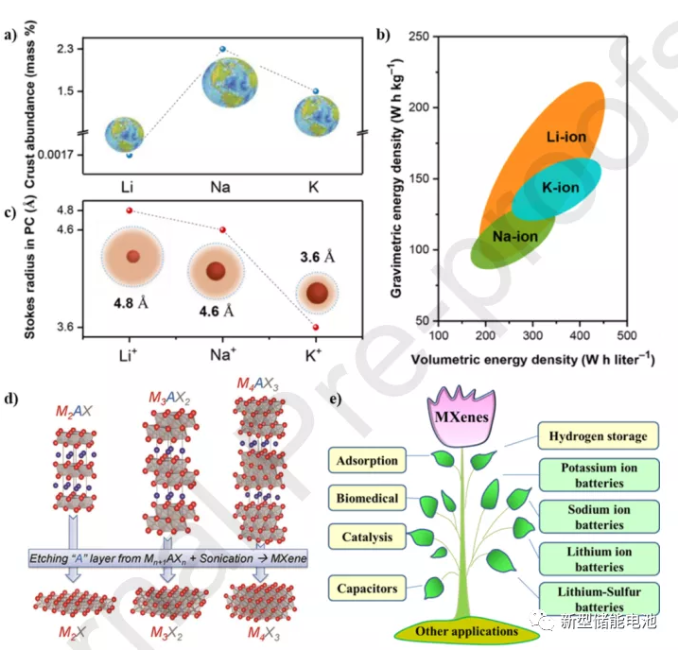
Figure 1 (a) The reserves of lithium, sodium and potassium in the earth‘s crust; (b) The comparison of the energy density of lithium, potassium and sodium ion batteries; (c) The ratio of lithium, sodium and potassium in propylene carbonate (PC) electrolyte Torx radius; (d) MAX phase and the structure of corresponding MXenes; (e) various applications of MXenes.
Graphic guide
1. Potassium storage mechanism of MXenes
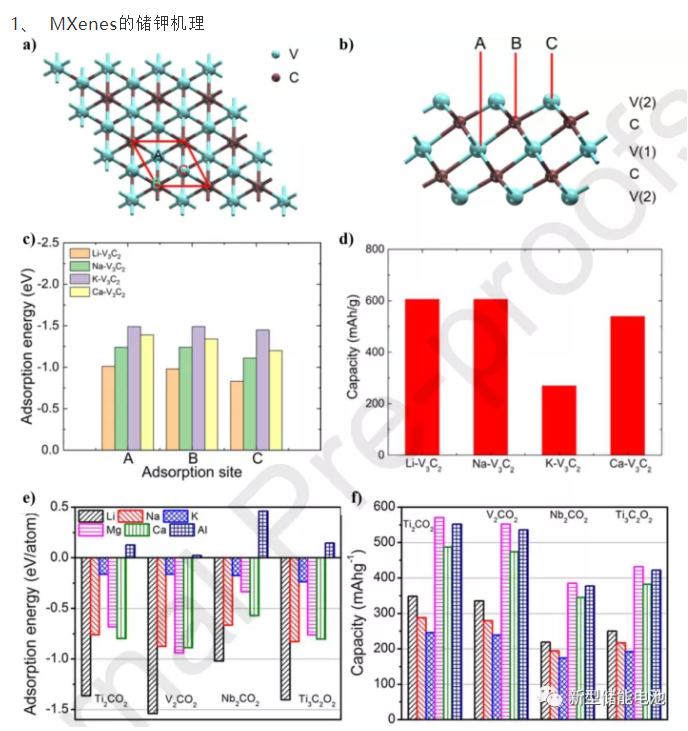
Figure 2 (a) Top view and side view of single-layer V3C2; (b) A, B, and C represent three possible atom adsorption sites; (c) A, B, and C three sites on single-layer V3C2 adsorb lithium The adsorption energy of sodium, potassium, calcium; (d) the maximum capacity of V3C2Lix, V3C2Nax, V3C2Kx and V3C2Cax; (e) the adsorption energy of several metal ions on some oxygen-terminated MXenes; (f) Ti2CO2, V2CO2, Theoretical capacity of Nb2CO2, Ti3C2O2

Figure 3 (a) Voltage specific capacity curve of Ti3CNTz electrode under different cycles; (b) dQ/dV-voltage graph based on the same data as 3a, the inset shows a partial enlarged view; (c) Ti3CNTz at 20 mA g-1 Cycle performance of current density; (d) XRD patterns of Ti3CNTz in different charge and discharge processes, showing the change of interlayer spacing; (e) Schematic diagram of the structure of Ti3CNO2 before and after electrochemical potassium insertion and removal. For simplicity, O2 is used instead of Tz.
2. Application of modified MXenes in potassium ion batteries
2.1 MXene-based composite materials
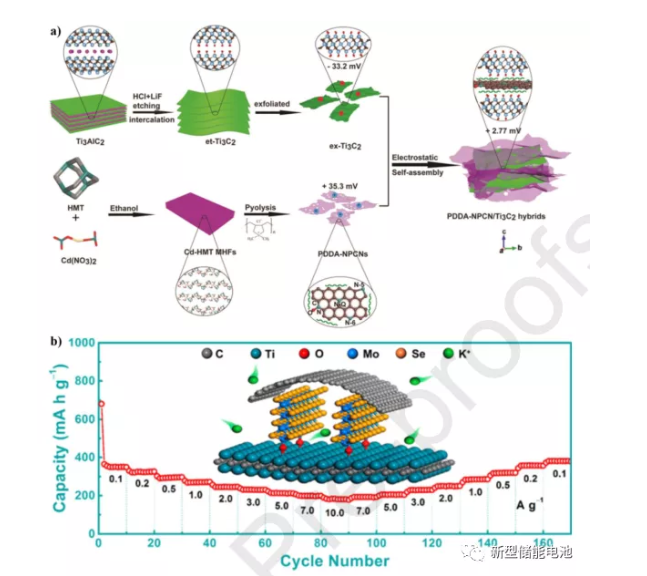
Figure 4 (a) Schematic diagram of the preparation of PDDA-NPCN/Ti3C2 mixture; (b) Schematic diagram of the structure of MoSe2/MXene@C and its rate performance.
2.2 Shape control of MXenes
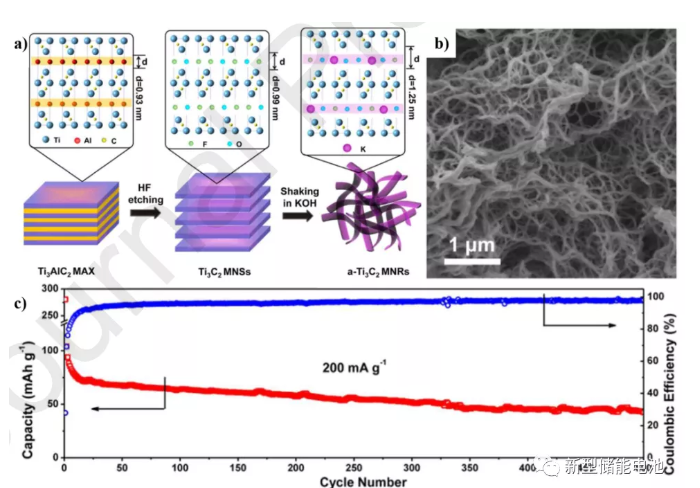
Figure 5 (a) Schematic diagram of the synthesis process of α-Ti3C2 MNRs and the interlayer spacing of the corresponding products; (b) Scanning electron micrograph of a-Ti3C2MNRs; (c) Cycle performance of a-Ti3C2 MNRs at 200 mA-1
2.3 MXene derivative materials
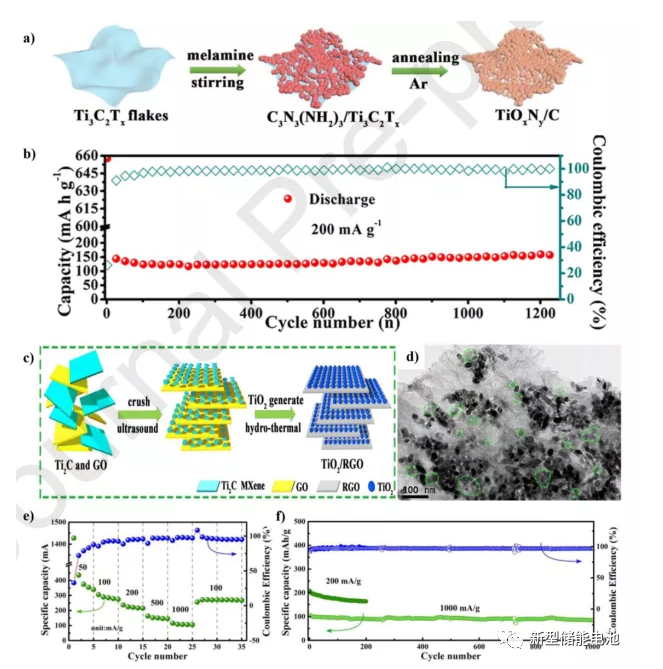
Figure 6 (a) Schematic diagram of the synthesis process of TiOxNy/C; (b) Cycle performance of TiOxNy/C at 200 mA g-1; (c) Schematic diagram of the synthesis process of TiO2/RGO; (d) TEM image of TiO2/RGO ; (E, f) TiO2/RGO rate and cycle performance
in conclusion
In short, although MXenes has good lithium storage performance, the shortage of lithium resources makes it difficult to use it in lithium batteries on a large scale. In addition, among other kinds of ion batteries, divalent or trivalent metal ion batteries have the advantage of high capacity, but Zn2+, Mg2+, Ca2+, Al3+ and other divalent or trivalent metal ions have higher charge density. , And easy to interact strongly with the electrode material, leading to slow diffusion kinetics. PIBs have become a kind of promising secondary battery by virtue of their working voltage close to lithium secondary battery and low price. It is believed that the combined development of potassium ion batteries and MXenes will attract more attention.
In summary, the preparation technology of MXenes electrode material still needs to be improved, and simplifying the preparation method and process is one of the key conditions for its commercialization. In addition, since the potassium storage capacity of most MXenes materials is not high enough, combining MXenes with other materials will be the next mainstream research direction. The key challenge is to coordinate the relationship between structure and performance. Carefully designing the structure of the material is an important factor in improving the electrochemical performance of MXene-based materials.
reference
Wu, Y., Sun, Y., Zheng, J., Rong, J., Li, H.,Niu,L: MXenes: Advanced Materials in Potassium Ion Batteries. Chemical Engineering Journal, 2020.
https://doi.org/10.1016/j.cej.2020.126565
Source of information: Material Madman
This information is from the Internet for academic exchanges. If there is any infringement, please contact us and delete it immediately

| Reminder: Beijing Beike New Material Technology Co., Ltd. supplies products only for scientific research, not for humans |
| All rights reserved © 2019 beijing beike new material Technology Co., Ltd 京ICP备16054715-2号 |